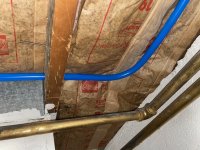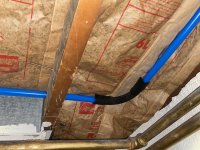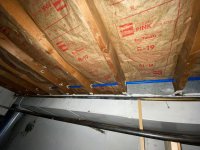To make things further confusing to me, Uponor's website says this in the FAQ section:
"Uponor PEX-a pipe expands at a rate of 1.1" (27.94 mm) for 100 ft. (30.48 m) of pipe for 10°F (5.56°C) temperature change. Using PEX-a Pipe Support with struts, strut clamps, clevis hangers or loop hangers will help control the expansion/contraction of the pipe to levels similar to that of copper pipe."
With this in mind, I would assume having an insulator "grabbing" the pipe every 16" would control the expansion and contraction.
Uponor's quote here is more akin to a material science discussion and not necessarily the installed condition (which is what you are interested in). I don't think they intended it, but it is confusing. Basically, their quote is saying take 100ft of their pipe (coiled on the ground, straight, whatever so long as it isn't attached to anything), heat it up 10deg F and it will grow in length by 1.1". This is not how anyone actually installs their pipe. As a code minimum, for a horizontal run, you have to secure it every 32" so in an installed condition (reality), in their 100ft run, there are probably at least 40 support points. And those support points will certainly provide some resistance to both expansion and contraction (longitudinal movement). So in reality, an installed 100ft run heated up 10deg F won't expand 1.1" but it probably isn't 0" either. How much it expands depends on how secure each of those support points is for resisting longitudinal movement of the pipe. If the pipe were to expand unrestricted the full 1.1", there would be no net increase in longitudinal stresses in the pipe (it expands outward from its center). If you restrain the pipe from expanding or contracting, you induce tension and compression in the pipe walls directed along the pipe length in between the support points that resist the movement. Do these stresses matter? I don 't know, but I haven't heard of anyone busting an uponor pex-a pipe because of something like this. My guess is the supports will allow movement if the pull/push gets too big and so not really overstress the pipe much. Its pretty hard to put in a straight run and have a taught (think suspension cable like) run of pex anyway because of how they are sold/stored in rolls. The rolls invariably induce some bulges between support points giving you your expansion/contraction loops.
I think what you are doing is fine. If you assume the unrestricted length is 32" between supports and a 10deg rise in temp occurs, the expansion becomes 1/32" between supports if the supports are strong enough to stop it. Bigger if they allow some movement. Another important point is that 10 degrees was their example but really, the actual expansion or contraction you will experience will be based on the difference between the temp of the pipe when you fastened it and the water temp running through it. If we assume 65 degrees for install (this is inside right?) and its a hot water pipe, then the temp change could be ~55 deg for an expansion of 5/32" with 32" support spacing. Contraction with cold water is even better because the temp delta is probably more like 20 degrees (at least in the winter) so same calc for contraction would be 1/16". If you really are worried, worry about the hot water pipe and just secure it more often. But I don't think you have an issue if you just run lines that aren't stretched tight and support them every 32".



